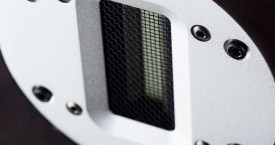Alexis Sound Rebecca Monitor loudspeaker

Indeed!
 It’s hard to forget the absolute magic that came from my first high-end audio rig. Can’t believe it’s been over twenty years now! That system consisted of a heavily modified Hafler amplifier, Krell preamp and an Audio Alchemy digital front-end driving a pair of Maggie 3.3s. All cabling was Kimber PBJ. In terms of performance per dollar, it was very impressive. The sound was big, ballsy, intensely transparent and, at the same time, intensely musical. Names like Dan D’Agostino, Mark Schifter, Bob Carver and Jim Winey bring a smile to my face because they remind me of my humble beginnings.
It’s hard to forget the absolute magic that came from my first high-end audio rig. Can’t believe it’s been over twenty years now! That system consisted of a heavily modified Hafler amplifier, Krell preamp and an Audio Alchemy digital front-end driving a pair of Maggie 3.3s. All cabling was Kimber PBJ. In terms of performance per dollar, it was very impressive. The sound was big, ballsy, intensely transparent and, at the same time, intensely musical. Names like Dan D’Agostino, Mark Schifter, Bob Carver and Jim Winey bring a smile to my face because they remind me of my humble beginnings.
Fast-forward to 2014 and we find ourselves in a very different milieu. Yes, there are still companies that make good sounding products at affordable prices, like PS Audio, April Music, Emotiva and Creek Audio to name a few. But nowadays we are dumbfounded at $150,000 price tags from Magico, Wavac or Audio Note and others. Sheer astonishment at these prices keeps guys like us looking their way and giving them our attention.
 And, perhaps far too often, we get fooled into believing that a high price tag is the cost of admission into the wild and crazy world of high-end audio. Of course, that just isn’t true. I define high-end audio by one thing and one thing only: performance.
And, perhaps far too often, we get fooled into believing that a high price tag is the cost of admission into the wild and crazy world of high-end audio. Of course, that just isn’t true. I define high-end audio by one thing and one thing only: performance.
Case in point: the Alexis Sound Rebecca monitor loudspeakers, retail price: $850.00!
Alexis Sound is comprised of a group of former DIYs (Do It Yourselfers). Ken Lin is the head task master behind the Rebecca but there are other designers, sharing similar passions, all involved in the choice of crossover parts, type of drivers, and the etc. After gaining some Internet notoriety in Taiwan for great sounding, budget-conscious loudspeakers, this team decided to turn professional and officially launched their first product, the Rebecca monitor. Their goal was to create an affordable, efficient transducer whose dynamic measurements were technically excellent.

The Rebecca is an average looking, two-way monitor employing a ribbon tweeter, the Alexis Ribbon One (AR1). This driver employs two powerful neodymium magnets and an ultra-light (18 mg) ribbon. This driver is said by the designers to have extremely smooth frequency response and lack the “etched” character that plagues some other ribbon designs. The 6.5″ midbass driver is sourced from the legendary SB Acoustics and boasts a rigid Open-Cast Aluminum frame. The Natural Sound Crossover (NSX) is the heart and soul of the Rebecca according to Ken Lin. Trying to avoid too much enthusiasm from Lin, I did some of my own research and found out some interesting facts.
The AR1 tweeter used in the Rebecca is the same one used in the $4,000 Monitor Audio PL100s. More suprisingly, the Rebecca’s 6.5″ mid/woofer is the same driver that is used in the $15,000 Wilson Audio’s Sophia (albeit, theirs is a modified model). So, how was Alexis Sound able to use these same costly drivers and keep the price so low? Direct sales (no dealer network) and next to nothing profit is my best guess.
The Rebecca’s overall build and finish is impressive. My review sample came in a Walnut veneer with five layers of satin finish (no plastics). The cabinet is 17” tall by 8 ½” wide by 10 ½” deep and design-wise, it’s a front-ported reflex. The cabinet is internally braced and uses 1” MDF for the baffle. Connectors consist of a single pair of 5-way binding posts, so bi-wiring is not possible. Of the variety of stands I had on hand, an old, reliable thick-legged pair of 24″ Target stands once again provided ideal.
System
Listening tests were carried out primarily using the Burson Audio Timekeeper and Wyred 4 Sound miNT, with an Alex Paychev-modified Philips 1000 SACD player and a Marantz 6500 CD player. I chose Plascenia & Hijos interconnects, Bybee Super Effect Speaker Cable, and Verastarr Silver Signatures power cords. Not counting the Bybee’s and Verastarr’s lofty costs, the components were quite affordably priced, like the Rebecca itself. And literally, right from the first note, they worked together to create a wonderful sonic blend.
 Recently I’ve been listening to Gregory Porter’s latest album, Liquid Spirit. This CD boasts 14 tracks and serves as Porter’s third release and his first for Bluenote Records. This wonderfully talented musician won a 2014 Grammy Award and his performance of “Hey Laura” here, places plenty of emphasis on his intensely rich vocal range. Here’s a voice that’s eerily reminiscent of some of my favorites like Nat King Cole, Joe Williams and Jon Lucien. You know right off the bat, when you mention any one of these jazz music icons, that you’re talking about a weighty and gutsy male voice that can shift almost to a low baritone growl. The Rebecca was nimbly skillful at allowing Porter’s voice to remain weighty, focused and authentic without a hint I was listening through a stand-mounted monitor with a limited frequency range.
Recently I’ve been listening to Gregory Porter’s latest album, Liquid Spirit. This CD boasts 14 tracks and serves as Porter’s third release and his first for Bluenote Records. This wonderfully talented musician won a 2014 Grammy Award and his performance of “Hey Laura” here, places plenty of emphasis on his intensely rich vocal range. Here’s a voice that’s eerily reminiscent of some of my favorites like Nat King Cole, Joe Williams and Jon Lucien. You know right off the bat, when you mention any one of these jazz music icons, that you’re talking about a weighty and gutsy male voice that can shift almost to a low baritone growl. The Rebecca was nimbly skillful at allowing Porter’s voice to remain weighty, focused and authentic without a hint I was listening through a stand-mounted monitor with a limited frequency range.
The Rebecca’s frequency range is rated from 42 Hz to 40 kHz, and for it to keep Gregory Porter so there, so alive, without sensing any loss of power in the lower frequencies points directly to a smooth, well-designed crossover and the cabinet’s impressive internal bracing. These combinded strengths do quite an act of hiding the Rebecca’s limited low frequency bandwidth. I think it’s awesome that this level of performance can be had in a loudspeaker costing less than a thousand bucks.
Upping the Ante
I decided to try the Rebeccas with slightly more expensive components to see how this monitor would behave. First up was the all-tube Starlet integrated from Von Gaylord Audio. The Starlet produces a respectable 50 watts of pure triode power, and is priced at $3500. It’s a well-known fact that tubes and ribbons are a symbiotic match (I experienced this with a Conrad Johnson amplifier and a pair of Maggie 3.3s). The results were pretty consistent with everyone else who paired the two: a dramatic increase in sound stage depth/width while the high frequencies seemingly gained more air and bloom. The Starlet and Rebecca twosome were no exception to this rule.
Further, using the Von Gaylord Starlet integrated in particular, the Rebecca’s ribbon sounded also a tad sweeter and radiant in color. Images appeared palpable and more holographic as well. It’s been my experience that tubes have an uncanny way of spotting up images on a three-dimensional plane better than their solid-state counterparts. That’s just the way it is. However, all things being equal, tubes do not offer the same level of transparency, speed and bass control as do solid-state components.
As rich and sweet as the Rebecca’s upper frequencies performed, I got the sensation that I was missing the ability to see into and beyond the performers as when listening through the Timekeeper or miNT. Yes, they’re little bit drier overall but the improved pitch in the bass, increased detail and overall solidity of the performance makes solid-state a winner too. Ultimately, what’s most important to your tastes is what counts. And what’s so great about the Rebecca is it doesn’t seem to favor one over the other. I sort of knew what to expect here listening to the Starlet and Timekeeper/miNT. The Rebecca exceeded my expectations in both instances.
A New Sheriff in Town
What you get with the Rebecca is a loudspeaker that will play what you feed it with aplomb. You cannot embarrass the Rebecca with an amplifier costing several times its asking price. Its limitations may become more obvious when you start placing it against monitors costing many times its asking price. I wouldn’t have been surprised one bit if the Rebecca had been priced at $2,500. And even at that price, I would have wholeheartedly recommend it for its wonderfully neutral stance and natural sounding character. Run, do not walk, to audition this incredibly affordable product.


Price: $850.00 USA
Specifications:
| Model | Rebecca Reference Monitor |
|---|---|
| Design | Two Way Reference Monitor Using Alexis Ribbon 1 tweeter and 6.5″ Alexis 65 Mid-woofer |
| Frequency Response | 42Hz to 40K Hz |
| Sensitivity (dB/2.83V/1M) | 86-87 dB |
| Impedance | 8 ohms |
| Recommended Amplification | 40 – 100 tube watts 80 – 250 solid state watts (See Note) |
| Dimensions | 8.5″ (W) x 17″ (H) x 10.25″ (D) |
| Weight | 21 kgs (Shipping Weight) |
Website:www.alexissound.com
Address:2565 Huntington Dr, Herndon, Virginia, 20171, USA
Email: info@alexissound.com
Stereo Times Masthead
Publisher/Founder
Clement Perry
Editor
Dave Thomas
Senior Editors
Frank Alles, Mike Girardi, Russell Lichter, Terry London, Moreno Mitchell, Paul Szabady, Bill Wells, Mike Wright, and Stephen Yan,
Current Contributors
David Abramson, Tim Barrall, Dave Allison, Ron Cook, Lewis Dardick, John Hoffman, Dan Secula, Don Shaulis, Greg Simmons, Eric Teh, Greg Voth, Richard Willie, Ed Van Winkle, Rob Dockery, Richard Doran, and Daveed Turek
Site Management Clement Perry
Ad Designer: Martin Perry





Be the first to comment on: Alexis Sound Rebecca Monitor loudspeaker